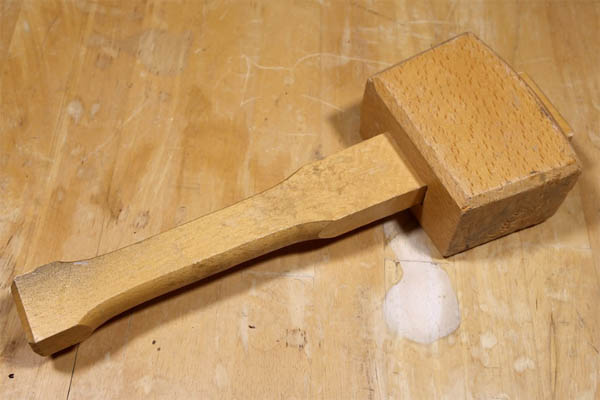Mallets: The Timeless Elegance of Woodworking Mallets
A mallet is a handheld hammer-like tool with a large, often wooden, head used for driving another tool such as a chisel or wedge.
It typically has a sturdy handle, allowing the user to apply controlled strikes to various surfaces or objects without causing excessive damage.
Mallets are commonly used in woodworking where precision and finesse are required.
They come in different shapes and sizes, each designed for specific tasks and materials.
The Essence of a Woodworking Mallet
At its core, a woodworking mallet is a testament to the elegance of simplicity. Crafted from materials like wood, rubber, or even metal, it boasts a stout handle and a solid, weighted head.
Unlike the brute force associated with its name, the mallet is a tool of finesse and precision.
Its purpose is multifaceted, bridging the gap between the artisan’s vision and the physicality of woodworking.
The Art of Persuasion: Mallet in Action
When delicacy is paramount, and a chisel needs a gentle nudge rather than a forceful blow, the woodworking mallet takes center stage. Its purpose is diverse:
- Chisel Control: Guiding a chisel through delicate wood grains demands control. The mallet’s measured strikes allow artisans to sculpt intricate details, bringing life to their creations.
- Joint Perfecting: In the realm of joinery, where pieces of wood harmonize seamlessly, the mallet persuades joints into snug fits. Its gentle taps coax elements into unity without damaging the meticulously crafted surfaces.
- Carving Grace: For woodcarvers, the mallet is a trusted companion, enabling the subtlest of movements to shape the wood, unveiling intricate patterns and textures.
- Assembly Aid: When disparate components align to form a cohesive whole, the mallet’s persuasive taps ensure a secure bond, guaranteeing the longevity of the finished piece.
Variety in Unity: The Diverse World of Woodworking Mallets
Just as every piece of wood tells a unique story, woodworking mallets come in a variety of shapes and sizes, each tailored to specific tasks:
- Carver’s Mallet: Featuring a cylindrical handle and a rounded head, it offers balance and precision, making it ideal for intricate carving work.
- Joiner’s Mallet: With a broader head and a flat striking surface, it excels in encouraging stubborn joints into alignment without leaving behind unsightly marks.
- Rubber Mallet: While purists might debate its inclusion, the rubber mallet has found its place, especially in delicate assemblies where a softer touch is required to avoid damaging delicate surfaces.
The Craftsperson’s Touch: Using the Woodworking Mallet Wisely
Utilizing a woodworking mallet is an art in itself, requiring finesse, patience, and a deep understanding of the materials at hand. Here’s how artisans wield this tool effectively:
1.) Precision in Every Tap
Every strike of the woodworking mallet is a deliberate act, a testament to the artisan’s skill.
Each tap is precisely calculated, aligning with the rhythm of the craftsman’s heartbeat and the pulse of creativity.
The angle at which the mallet meets the chisel or the wood is a carefully calculated dance, ensuring that the force is distributed evenly, bringing out the desired shapes and textures.
2.) Understanding the Wood
Wood is a living material, each type possessing its unique characteristics and idiosyncrasies.
A seasoned craftsman comprehends the nature of the wood being worked upon – its grain, density, and even moisture content.
This understanding guides the force applied by the mallet. A softer wood might require a lighter touch, while a denser variety demands a bit more persuasion.
Mastery lies in the ability to listen to the wood, feeling its response to the mallet’s touch.
3.) Patience as a Virtue
Woodworking, like all art forms, requires patience. Rushed strikes and hasty decisions lead to mistakes that can mar hours of meticulous work.
The woodworking mallet teaches patience. It demands a steady hand, a calm mind, and the willingness to listen to the subtle cues the wood provides.
Impatience leads to errors; patience leads to perfection.
4.) Maintenance and Respect
A woodworking mallet is not just a tool; it is an investment. Craftsmen take pride in their tools and ensure they are well-maintained.
The handle is kept smooth, free from splinters, allowing for a comfortable grip. The head is inspected for any signs of wear, ensuring its weight remains balanced.
Respect for the tool is paramount. It is cleaned after every use, oiled to maintain its natural luster, and stored carefully, ready for the next artistic endeavor.
5.) Continuous Learning
The mastery of any craft is a journey, not a destination. Even the most experienced artisans continuously seek to refine their skills.
They attend workshops, learn from fellow craftsmen, and experiment with new techniques. In the world of woodworking, every project offers a lesson.
Every stroke of the mallet teaches something new – a subtlety of technique, a nuance in handling, or an innovative way to approach a challenge. A craftsman’s wisdom grows with every tap of the mallet.
Conclusion
The woodworking mallet embodies the soul of craftsmanship. It is not merely a tool but an extension of the artisan’s spirit, connecting their vision to the raw material and transforming it into something extraordinary.
The elegance of woodworking lies not just in the final creation but in the journey, the intimate relationship between the craftsman, the mallet, and the wood.
As long as there are artisans with passion and dedication, the timeless elegance of woodworking mallets will continue to shape exquisite creations, reminding the world of the beauty that emerges when human ingenuity meets nature’s bounty.

Don Kerr spent many years honing his skills as a DIY woodworker. He finds immense joy in not only creating remarkable pieces but also in generously sharing his knowledge. Connect with him via group.



